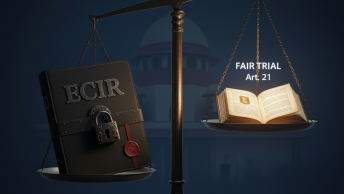In Part I, through the cases of Sharat Babu Digumarti v. Govt. of NCT of Delhi and Gagan Harish Sharma v. The State of Maharashtra , we understood the position of law with respect to the simultaneous applicability of the Indian Penal Code [“IPC”] and the Information Technology Act [“IT Act”]. For actions attracting offences with similar ingredients under both these statutes, an accused can only be charged under the IT Act due to application of principles of lex specialis and double jeopardy. Such as accused is thus held to have escaped the net of the IPC, and can take advantage of the relatively lenient punishments under the IT Act. As seen in Part I, this position of law has been hailed as legally sound. However, despite this legal soundness, there is a glaring problem with this position of law.
Problem of Differentiated Punishments, Bail and Compoundable Offences
As per the position of law outlined above, if an action attracts the offence provisions of the IT Act [that is, if it involves electronic means], then the IPC cannot be applied. For offences not involving electronic means however, the IPC is still applicable. Thus, the effect of this position of law is that different statutes are applicable for different forms or ways [electronic/non-electronic] of essentially committing the same offence.
Such checkerboard applicability of statutes is extremely problematic given that the bail and the compoundable-nature related provisions of the IT Act are much more lenient than the IPC. For instance, if A impersonates C and cheats B face-to-face, A faces a penalty of seven years imprisonment/fine [Section 420 IPC]. In contrast, where A impersonates C and cheats B using email, A will be liable for three years imprisonment/fine upto Rs. 1 lakh. Additionally, in the former case, A is not entitled to bail as a right, and can compound his charges only with the court’s permission. In contrast, in a latter case, A has a right to get bail, and his offence is compoundable.
As seen through the above example, distinction in terms bailable/compoundable nature and punishment is created for the same offence merely on the basis of form or medium of commission of offence [electronic/non-electronic]. Moreover, due to this arbitrary differentiation, sophisticated criminals who have the ability to use electronic means to commit a crime [such as the affluent businessmen who were the accused in Sharat Babu and Gagan Sharma] get away with a lighter sentence as compared to the everyday roadside criminal. Alternatively, one roadside criminal receives a heavier sentence than another. In this manner, the checkerboard applicability of the two statutes is not only arbitrary, but also disproportionately affects some more than others.
Does There Exist an Unconstitutionality?
Article 14 of the Indian Constitution provides that the State shall not deny to any person equality before the law or the equal protection of the laws within the territory of India. There are two tests used to determine if Article 14 has been violated – the reasonable classification test and the arbitrariness test, both of which are simultaneously applicable. As mentioned in State of West Bengal v. Anwar Ali Sarkar [AIR 1952 SC 75], Air India v. Nargesh Mirza [AIR 1981 SC 1829] and recently in Rajbala v. Haryana [AIR 2016 SC 33] the reasonable classification test does not insist that every piece of legislation must have universal application and it does not take away from the State the power to classify persons for the purposes of legislation. Rather, it insists that the classification must be founded on intelligible differentia, and that differentia must have a rational nexus to the object to be achieved by the legislation. Essentially, if similarly situated persons are differently treated, the reasonable classification test is violated. Moreover, as mentioned in Shayara Bano v. Union of India [AIR 2017 SC 4609] and Joseph Shine v. Union of India [2017 (5) KHC 1001], the standard of arbitrariness required to violate Article 14 is met if a law is disproportionate, excessive, lacks any logicality of approach or is otherwise manifestly unreasonable. Additionally, in it important to note that in Anuj Garg v. The Hotel Association of India [AIR 2008 SC 663], it has been categorically held that a law that causes disproportionate impact on a particular class is violative of Article 14.
Applying the aforementioned tests to the present situation, it can be argued that the different standards of punishment, bail and compounding in the IT Act are violative of Article 14. This is because the distinction between those who use electronic means to commit an offence and those who do not lacks any intelligible differentia, and is also manifestly unreasonable. Normally, the punishment for a crime is determined on the basis of its severity. Presently, a different punishment is being stipulated for essentially the same offence, with the same severity. Hence, similarly situated people are treated differently, and Article 14 is violated.
If at all there has to be a differentiation, it must be reasonable and must not cause disproportionate impact on any particular class. Presently, the provisions of the IT Act are more lenient than the IPC. Thus, instead of having higher penalties for more advanced technology-based crime that has the potential to hit a large number of people in today’s internet-based world, the law is in fact imposing considerably higher penalties on a particular class of people who have not committed such sophisticated crimes, and may not have the ability to. Crudely put, the sophisticated criminal gets away while the ordinary criminal is penalised more. Thus, the relatively lenient provisions of the IT Act are disproportionately impacting a particular class and are thus violative of Article 14.
Possible Solutions
There are several ways to correct the unreasonable distinctions demonstrated above, both judicial and legislative. By going the judicial way, the constitutionality of the IT Act punishments and related provisions can be challenged and may be declared unconstitutional. In this manner, the accused can only be charged under the IPC.
Through the legislative way, there are atleast three options. One option is to make suitable amendments to either the IT Act or the IPC to harmonize the punishments, and bailable/compoundable nature of offences. Alternatively, the legislature can also choose to expand only the IPC, that is, it can bring about requisite amendments to subsume even electronically-committed offences under the IPC in order to correct the situation. A third alternative is that the legislature can consciously choose to maintain different punishments and bail/compounding provisions, but it must base these different provisions on an intelligible differentia such that they have a rational nexus with the object of the statute. A possible differentiation here is to consider electronic-mode offences as graver and capable of making a bigger impact as compared to the others and consequently stipulating higher punishments in the IT Act than the IPC. All in all, it is imperative that some or the other solution is adopted in order to remedy the problem.








Thanks for sharing. I read many of your blog posts, cool, your blog is very good.
Can you be more specific about the content of your article? After reading it, I still have some doubts. Hope you can help me. https://www.binance.info/vi/register-person?ref=WTOZ531Y